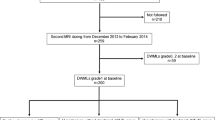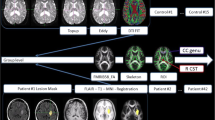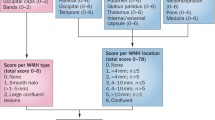Abstract
Introduction
Whether the degree of white matter hyperintensities (WMHs) shows a significant correlation with the rate of global gray matter volume decline over a period following initial baseline measurement remains unclear. The purpose of the present study was to reveal the relationship between the degree of WMHs at baseline and the rate of global gray matter volume decline by applying a longitudinal design.
Methods
Using a 6-year longitudinal design and magnetic resonance images of the brains of 160 healthy individuals aged over 50 years and living in the community, we analyzed the correlation between degree of WMHs using Fazekas scaling at baseline and rate of global gray matter volume decline 6 years later. To obtain the rate of global gray matter volume decline, we calculated global gray matter volume and intracranial volume at baseline and at follow-up using a fully automated method.
Results
The annual percentage change in the gray matter ratio (GMR, APCGMR), in which GMR represents the percentage of gray matter volume in the intracranial volume, showed a significant positive correlation with the degree of deep WMHs and periventricular WMHs at baseline, after adjusting for age, gender, present history of hypertension, and diabetes mellitus.
Conclusion
Our results suggest that degree of WMHs at baseline predicts the rate of gray matter volume decline 6 years later and that simple visual scaling of WMHs could contribute to predicting the rate of global gray matter volume decline.

Similar content being viewed by others
References
Good CD, Johnsrude IS, Ashburner J, Henson RNA, Friston KJ, Frackowiak RSJ (2001) A voxel-based morphometric study of ageing in 465 normal adult human brains. Neuroimage 14:21–36
Taki Y, Goto R, Evans A, Zijdenbos A, Neelin P, Lerch J, Sato K, Ono S, Kinomura S, Nakagawa M, Sugiura M, Watanabe J, Kawashima R, Fukuda H (2004) Voxel-based morphometry of human brain with age and cerebrovascular risk factors. Neurobiol Aging 25:455–463
Fotenos AF, Snyder AZ, Girton LE, Morris JC, Buckner RL (2005) Normative estimates of cross-sectional and longitudinal brain volume decline in aging and AD. Neurology 64:1032–1039
Kramer JH, Mungas D, Reed BR, Wetzel ME, Burnett MM, Miller BL, Weiner MW, Chui HC (2007) Longitudinal MRI and cognitive change in healthy elderly. Neuropsychology 21:412–418
Zimmerman ME, Brickman AM, Paul RH, Grieve SM, Tate DF, Gunstad J, Cohen RA, Aloia MS, Williams LM, Clark CR, Whitford TJ, Gordon E (2006) The relationship between frontal gray matter volume and cognition varies across the healthy adult lifespan. Am J Geriatr Psychiatry 14:823–833
Longstreth WT Jr, Manolio TA, Arnold A, Burke GL, Bryan N, Jungreis CA, Enright PL, O'Leary D, Fried L (1996) Clinical correlates of white matter findings on cranial magnetic resonance imaging of 3301 elderly people. The Cardiovascular Health Study. Stroke 27:1274–1282
Oosterman JM, Van Harten B, Weinstein HC, Scheltens P, Sergeant JA, Scherder EJ (2008) White matter hyperintensities and working memory: an explorative study. Aging Neuropsychology & Cognition 15:384–399
Oosterman JM, Vogels RL, van Harten B, Gouw AA, Scheltens P, Poggesi A, Weinstein HC, Scherder EJ (2008) The role of white matter hyperintensities and medial temporal lobe atrophy in age-related executive dysfunctioning. Brain Cogn 68:128–133
Nebes RD, Meltzer CC, Whyte EM, Scanlon JM, Halligan EM, Saxton JA, Houck PR, Boada FE, Dekosky ST (2006) The relation of white matter hyperintensities to cognitive performance in the normal old: education matters. Aging Neuropsychology & Cognition 13:326–340
Basile AM, Pantoni L, Pracucci G, Asplund K, Chabriat H, Erkinjuntti T, Fazekas F, Ferro JM, Hennerici M, O'Brien J, Scheltens P, Visser MC, Wahlund LO, Waldemar G, Wallin A, Inzitari D, LADIS Study G (2006) Age, hypertension, and lacunar stroke are the major determinants of the severity of age-related white matter changes. The LADIS (Leukoaraiosis and Disability in the Elderly) Study. Cerebrovasc Dis 21:315–322
Park MK, Jo I, Park MH, Kim TK, Jo SA, Shin C (2005) Cerebral white matter lesions and hypertension status in the elderly Korean: the Ansan Study. Arch Gerontol Geriatr 40:265–273
Taki Y, Kinomura S, Sato K, Goto R, Inoue K, Okada K, Ono S, Kawashima R, Fukuda H (2006) Both global gray matter volume and regional gray matter volume negatively correlate with lifetime alcohol intake in non-alcohol-dependent Japanese men: a volumetric analysis and a voxel-based morphometry. Alcohol Clin Exp Res 30:1045–1050
Taki Y, Kinomura S, Sato K, Inoue K, Goto R, Okada K, Uchida S, Kawashima R, Fukuda H (2008) Relationship between body mass index and gray matter volume in 1, 428 healthy individuals. Obesity 16:119–124
Wen W, Sachdev PS, Chen X, Anstey K (2006) Gray matter reduction is correlated with white matter hyperintensity volume: a voxel-based morphometric study in a large epidemiological sample. Neuroimage 29:1031–1039
Fazekas F, Chawluk JB, Alavi A, Hurtig HI, Zimmerman RA (1987) MR signal abnormalities at 1.5 T in Alzheimer's dementia and normal aging. AJR Am J Roentgenol American Journal 149:351–356
Sato K, Taki Y, Fukuda H, Kawashima R (2003) Neuroanatomical database of normal Japanese brains. Neural Netw 16:1301–1310
Folstein MF, Folstein SE, McHugh PR (1975) Mini-mental state. A practical method for grading the cognitive state of patients for the clinician. J Psychiatr Res 12:189–198
Friston KJ, Holmes AP, Worsley KJ, Poline J-P, Frith CD, Frackowiak RSJ (1995) Statistical parametric maps in functional imaging: a general linear approach. Hum Brain Mapp 2:189–210
Talairach J, Tournoux P (1988) Co-planar stereotaxic atlas of the human brain. Georg Thieme, Stuttgart
Ashburner J, Neelin P, Collins DL, Evans A, Friston K (1997) Incorporating prior knowledge into image registration. Neuroimage 6:344–352
Rossi R, Boccardi M, Sabattoli F, Galluzzi S, Alaimo G, Testa C, Frisoni GB (2006) Topographic correspondence between white matter hyperintensities and brain atrophy. J Neurol 253:919–927
Firbank MJ, Wiseman RM, Burton EJ, Saxby BK, O'Brien JT, Ford GA (2007) Brain atrophy and white matter hyperintensity change in older adults and relationship to blood pressure. Brain atrophy, WMH change and blood pressure. J Neurol 254:713–721
Brickman AM, Zahra A, Muraskin J, Steffener J, Holland CM, Habeck C, Borogovac A, Ramos MA, Brown TR, Asllani I, Stern Y (2009) Reduction in cerebral blood flow in areas appearing as white matter hyperintensities on magnetic resonance imaging. Psychiatry Res 172:117–120
Bastos-Leite AJ, Kuijer JP, Rombouts SA, Sanz-Arigita E, van Straaten EC, Gouw AA, van der Flier WM, Scheltens P, Barkhof F (2008) Cerebral blood flow by using pulsed arterial spin-labeling in elderly subjects with white matter hyperintensities. AJNR Am J Neuroradiol 29:1296–1301
Meyer JS, Rauch GM, Crawford K, Rauch RA, Konno S, Akiyama H, Terayama Y, Haque A (1999) Risk factors accelerating cerebral degenerative changes, cognitive decline and dementia. Int J Geriatr Psychiatry 14:1050–1061
Appelman AP, van der Graaf Y, Vincken KL, Tiehuis AM, Witkamp TD, Mali WP, Geerlings MI, SMART Study G (2008) Total cerebral blood flow, white matter lesions and brain atrophy: the SMART-MR study. J Cereb Blood Flow Metab 28:633–639
Symon L, Pasztor E, Dorsch NW, Branston NM (1973) Physiological responses of local areas of the cerebral circulation in experimental primates determined by the method of hydrogen clearance. Stroke 4:632–642
Young RS, Hernandez MJ, Yagel SK (1982) Selective reduction of blood flow to white matter during hypotension in newborn dogs: a possible mechanism of periventricular leukomalacia. Ann Neurol 12:445–448
Pantoni L, Garcia JH (1997) Pathogenesis of leukoaraiosis: a review. Stroke 28:652–659
Le Bihan D (2003) Looking into the functional architecture of the brain with diffusion MRI. Nat Rev Neurosci 4:469–480
van Buchem MA, Udupa JK, McGowan JC, Miki Y, Heyning FH, Boncoeur-Martel MP, Kolson DL, Polansky M, Grossman RI (1997) Global volumetric estimation of disease burden in multiple sclerosis based on magnetization transfer imaging. AJNR Am J Neuroradiol 18:1287–1290
Ropele S, Seewann A, Gouw AA, van der Flier WM, Schmidt R, Pantoni L, Inzitari D, Erkinjuntti T, Scheltens P, Wahlund LO, Waldemar G, Chabriat H, Ferro J, Hennerici M, O'Brien J, Wallin A, Langhorne P, Visser MC, Barkhof F, Fazekas F, LADIS study group (2009) Quantitation of brain tissue changes associated with white matter hyperintensities by diffusion-weighted and magnetization transfer imaging: the LADIS (Leukoaraiosis and Disability in the Elderly) study. J Magn Reson Imaging 29:268–274
Abe O, Yamasue H, Aoki S, Suga M, Yamada H, Kasai K, Masutani Y, Kato N, Kato N, Ohtomo K (2008) Aging in the CNS: comparison of gray/white matter volume and diffusion tensor data. Neurobiol Aging 29:102–116
Ibrahim I, Horacek J, Bartos A, Hajek M, Ripova D, Brunovsky M, Tintera J (2009) Combination of voxel based morphometry and diffusion tensor imaging in patients with Alzheimer's disease. Neuroendocrinology Letters 30:39–45
Fazekas F, Kleinert R, Offenbacher H, Schmidt R, Kleinert G, Payer F, Radner H, Lechner H (1993) Pathologic correlates of incidental MRI white matter signal hyperintensities. Neurology 43:1683–1689
Scheltens PM, Barkhof FM, Leys DM, Wolters ECM, Ravid RP, Kamphorst WM (1995) Histopathologic correlates of white matter changes on MRI in Alzheimer's disease and normal aging. Neurology 45:883–888
Acknowledgements
We thank K. Inoue and K. Okada for insightful comments, and K. Inaba, K. Saito, N. Ishibashi, and H. Masuyama for technical help in collecting data.
This study was funded by the National Institute of Mental Health, the National Institute of Neurological Disorders and Stroke, the National Institute on Drug Abuse and the U.S. National Cancer Institute. Part of this research was supported by a grant from the Telecommunications Advancement Organization of Japan. This study was also supported in part by the 21st Century Center of Excellence (COE) Program (Ministry of Education, Culture, Sports, Science and Technology; MEXT), entitled "Future Medical Engineering-based Bio-nanotechnology" at Tohoku University, and a grant from the JSPS-CIHR Joint Health Research Program. This work was also supported by the MEXT Grant-in-Aid for Young Scientists (B), 18790864.
Conflict of interest statement
We declare that we have no conflict of interest.
Author information
Authors and Affiliations
Corresponding author
Rights and permissions
About this article
Cite this article
Taki, Y., Kinomura, S., Sato, K. et al. Correlation between degree of white matter hyperintensities and global gray matter volume decline rate. Neuroradiology 53, 397–403 (2011). https://doi.org/10.1007/s00234-010-0746-x
Received:
Accepted:
Published:
Issue Date:
DOI: https://doi.org/10.1007/s00234-010-0746-x




